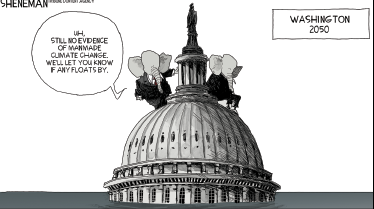As a cautious, apolitical group of scientists, the Intergovernmental Panel on Climate Change simply isn’t in the business of chastising politicians or promoting a particular agenda. So when the panel, under the aegis of the United Nations, tells us that our one and only planet is teetering on the precipice of a veritable climate genocide, we have permission to hit the panic button. Per its report, released last week, our world must utterly transform its economy and energy systems in the next decade or risk ecological disaster on a biblical scale. It’s clear that the time to wake up and pay attention was about 10 years ago.
The report found that if carbon emissions continue at the current rate, the atmosphere will warm by as much as 1.5 degrees Celsius (2.7 degrees Fahrenheit) above pre-industrial levels by 2040. Previous research — including that used to formulate the tenets of the Paris Climate Agreement in 2015 — focused on estimating the damage if global surface temperature were to rise by two degrees Celsius (3.6 degrees Fahrenheit) because that was the increase at which scientists agreed the most severe impacts of climate change would come into operation. The new research, however, indicates that many of those effects will occur even sooner, with just a 1.5 degrees Celsius temperature gain. No longer is two degrees of warming considered an “acceptable” upper limit for climate change. And even if the signatory countries of the Paris Climate Accords were abiding by the tenets of the agreement (which largely they aren’t), those measures still wouldn’t be enough.
Avoiding the suffering that a plus-two degrees Celsius world would bring, the report says, requires such a thorough transformation of the world’s economy, agriculture and culture that “there is no documented historical precedent.” Perhaps the closest comparison is the mobilization of the citizenry during World War II — and that required a working norm of rationing and individual sacrifice that few Americans today remember or witnessed.
Admittedly, we tend to trivialize the differences between one degree of warming and two, between three degrees and four. Recall that the report’s best-case scenario was an increase in global surface temperature of 1.5 degrees, and even that amount of warming would still cause storms, wildfires, floods, droughts and coral bleaching events of unprecedented severity. The planet, however, is coursing along a trajectory that will bring four degrees of warming by the end of the century — so even the devastating impacts of 1.5 degrees may be too optimistic.
The U.K.-based think tank Carbon Brief: Clear on Climate recently aggregated more than 6,000 peer-reviewed studies on what two, three and four degrees of climate change would look like; the results are sobering and must be reckoned with.
At two degrees, global gross domestic product per capita would drop by 13 percent and 400 million more people would suffer from water scarcity. In India, highly-populated cities would become uninhabitably hot, and there would be 32 times as many extreme heat waves, each lasting five times as long and exposing, in total, 93 times more people. This is the best-case scenario.
At three degrees, the average drought in Central America would last 19 months. In northern Africa, droughts would last five years. The areas burned each year by wildfires would double in the Mediterranean and increase six-fold in the U.S. The sea-level rise would swallow cities such as Osaka, Japan; Alexandria, Egypt; Rio de Janeiro, Brazil and Shanghai, China.
At four degrees, global grain yields could fall by as much as 50 percent, producing food crises and possibly war. There would be eight million cases of dengue fever each year in Latin America alone. The melting Arctic ice sheet could release diseases and pathogens that it has locked up for decades or even centuries, from the 1918 Spanish flu to the bubonic plague. The global economy would be more than 30 percent smaller than it would be without climate change.
So how do we save ourselves when we have so little time? According to the report, global carbon emissions would need to decline by at least 40 percent by 2030 and reach net zero by 2050. This will be no easy task; last year global carbon emissions hit an all-time high.
Many people will see the kind of change we need as extreme and politically untenable — but they’ll have to get used to it. Rationing of gasoline is inevitable and should be put on the table as soon as possible. Regularly scheduled blackouts would also be a good idea. Perhaps a third political party devoted entirely to climate issues will need to coalesce. Given that recent research indicates that 100 companies are responsible for 71 percent of carbon emissions, corporations will need to be held accountable at an unprecedented level — including via massive carbon taxes. (More on this in a future column). And if we want to leave a livable world for our children — nay, if we can have children at all in good conscience — there can be no future for the coal or oil industries.
Meanwhile, our elected “leaders” are imitations of Nero, fiddling while the city of Rome burns. “I’m the President of the United States. I’m not the President of the globe,” Trump thundered at a recent rally. But on what planet does he think this great country resides?













